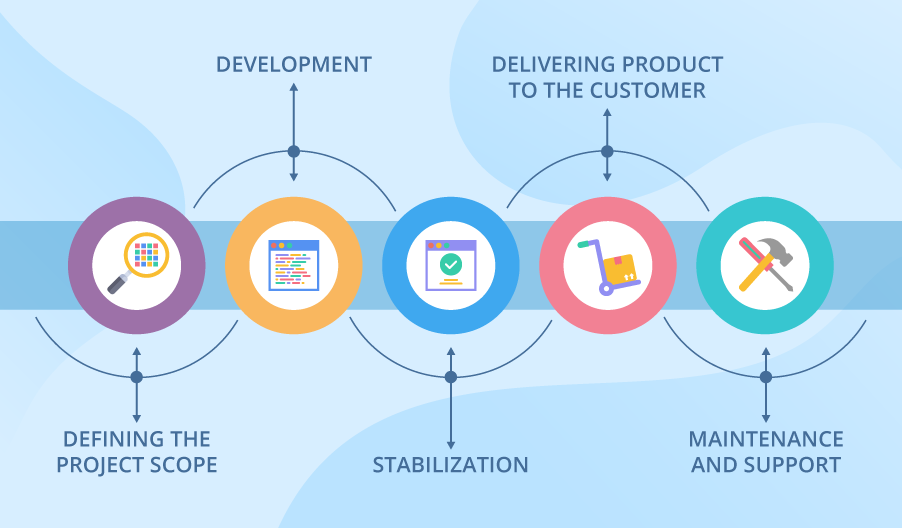Software development life cycle examples
The software development life cycle (SDLC) describes stages of software development and the order in which these stages should be implemented. Each stage produces deliverables for the next one.
Stages of SDLC
- Defining the project scope. After a customer and a vendor initiate a project, the project manager on the vendor’s side assigns the project team. Together with the customer, they define the project scope through requirement gathering and analysis.
- Development. At this stage, the developers prepare a system design and define the overall system architecture. The PM decides on the software development approach and pricing model. Then, the project team gets down to implementing and integrating the required features.
- Stabilization. Now, testing engineers check the software to ensure that its quality is acceptable and the product serves the intended purpose. The developers fix bugs.
- Delivering product to the customer. After testing and bug fixing, the final version of the software is delivered to the customer.
- Maintenance and support. The project team takes care of the developed product even after its release, improving it upon the customer’s request and continuously troubleshooting the product.

To see how project teams follow the SDLC, let’s look at several software development life cycle examples based on real-life projects carried out by ScienceSoft.
Innovative CMS platform
The project was initiated upon the request of a company delivering web content management solutions. Discussing the project scope, we found out that the customer needed to turn around their content management system (CMS) to create a brand-new product with advanced UI. The new CMS was to provide the most intuitive and efficient way to create and manage websites, intranets and mobile solutions for enterprises.
With this in mind, we got down to the platform development. The PM decided to build the solution applying the Agile software development methodology, which allowed a gradual evolution of the system. The team started with using an open source web framework but replaced it with a custom web framework, which helped protect the API of the CMS from any unpredictable change associated with using open source software. Then, working in short iterations, the team enriched the CMS with responsive admin UI and a visual editor providing rich design options for layout templates. Besides, we made the platform support real-time updates and ensured secure access to its content.
At the solution stabilization stage, a test automation specialist ensured that the system worked as intended. The custom web framework we created specifically for this project facilitated continuous and efficient testing.
Then the product was finally delivered to the customer. They got an innovative CMS platform with modern and flexible architecture.
Our team has been supporting and maintaining the platform for 4+ years already. The cooperation between the customer and our outsourced development team has strengthened over the years after the product launch and turned into a strategic and friendly relationship.
Hybrid applications for streaming
A company providing video streaming services requested the assistance of our outsourcing software development specialists to advance their streaming services provision. The project scope included hybrid applications development for users to watch online streams on smartphones, tablets, TV, gaming consoles and in browsers.
Getting down to the application’s development, a team of our mobile application developers joined the customer’s project team under T&M pricing model. In the course of the project, we created a framework based on Backbone.js, which decreased development costs and accelerated solution delivery. The new architecture made it easy to update, implement new features and manage UI/UX in the cloud. We also added the SVOD (Subscription video on demand) and movie rental features, which ensured smoother user experience in video content management.
After the product stabilization, we successfully delivered customizable multi-screen applications requested by the customer.
We have been partnering with the customer for 5+ years already, ensuring the product’s maintenance and extending the framework.
Alternative web browser
Outsourcing software development to our company, a web surfing solutions provider wanted to get an all-in-one web browser combining numerous media applications and services for Mac.
We started with defining the project scope. It included the creation of a Mac version of the browser, a system of updates for Mac and Windows, a system of auto-updates, and enabling torrent downloads directly from the browser.
After defining the project requirements, ScienceSoft got down to the software development phase. Like in the previous software development life cycle examples, our PM chose the Agile software development model. Thus, the solution got several releases with the required features implemented in each new release.
First, we finished the Chromium-based browser for Mac and created a custom Mac installer. Then, we proceeded to the implementation of the requested system of updates and an auto-updates subsystem. After that, we catered for high-speed and handy torrent downloads directly from the browser. At the end, we integrated the browser with major social networks and content sharing platforms, making it a single access point for them.
After the solution stabilization, we delivered the software to the customer. So, they got a browser that integrates various music and video storage places relieving users from the necessity to navigate among numerous web applications to enjoy their favorite media content.
Our support and maintenance team has been involved in improving the browser user experience for two years by regularly updating it and delivering new features.
Summing up
These illustrative software development life cycle examples show that the customer can get a high-quality product meeting their expectations provided the project team follow SDLC. Defining project scope correctly is of critical importance in the project flow as developers should understand what they are expected to build and create a clear plan how to do it. Neglecting the customers’, stakeholders’ or users’ needs can result in a project failure. At the beginning of the development stage, the project team chooses a software development approach and pricing model. After they have implemented and integrated all the required features, testing engineers assure the quality of the software. After the software is delivered to the customer, the developers continue maintaining and supporting the delivered product or solution.

